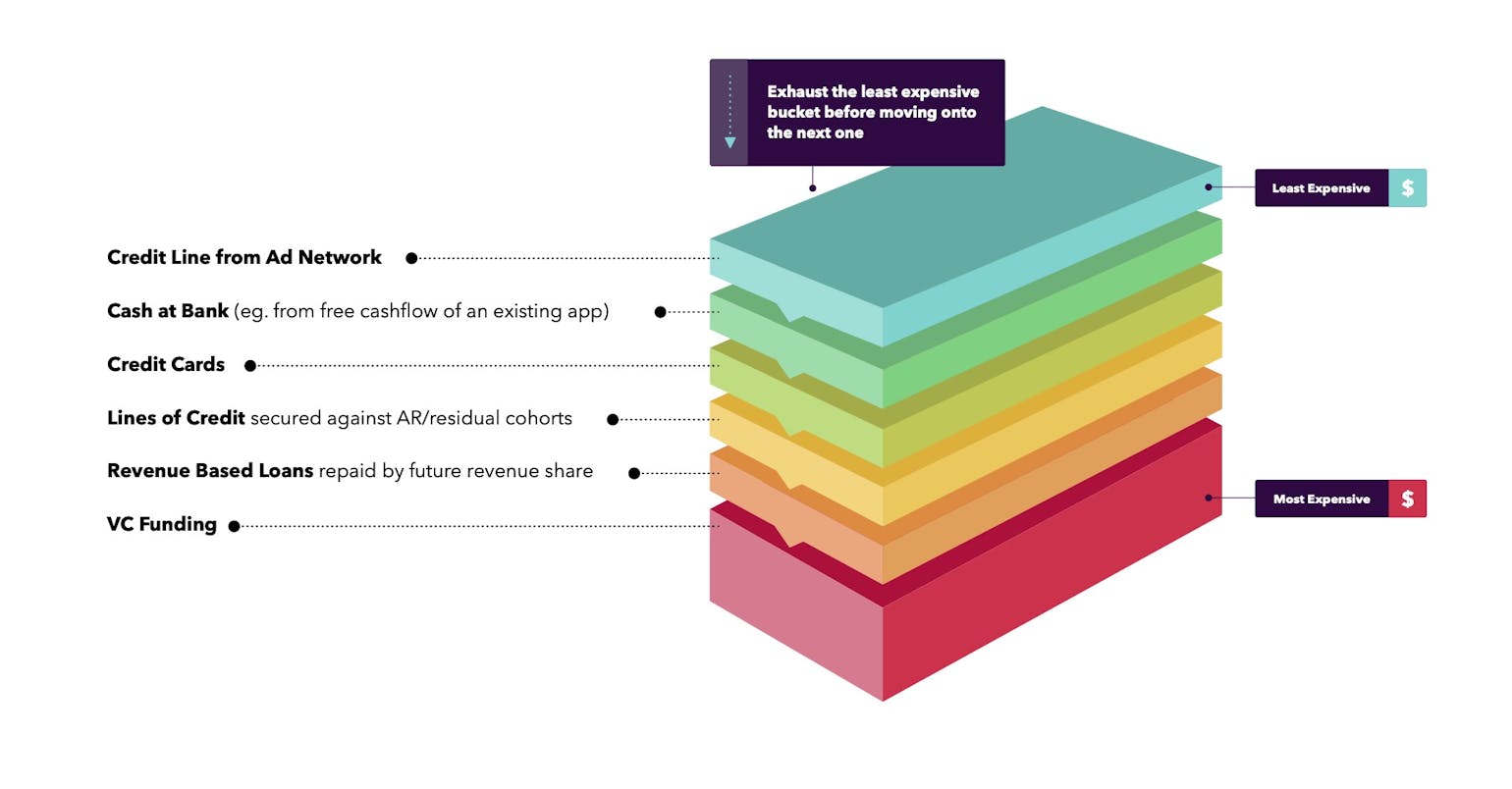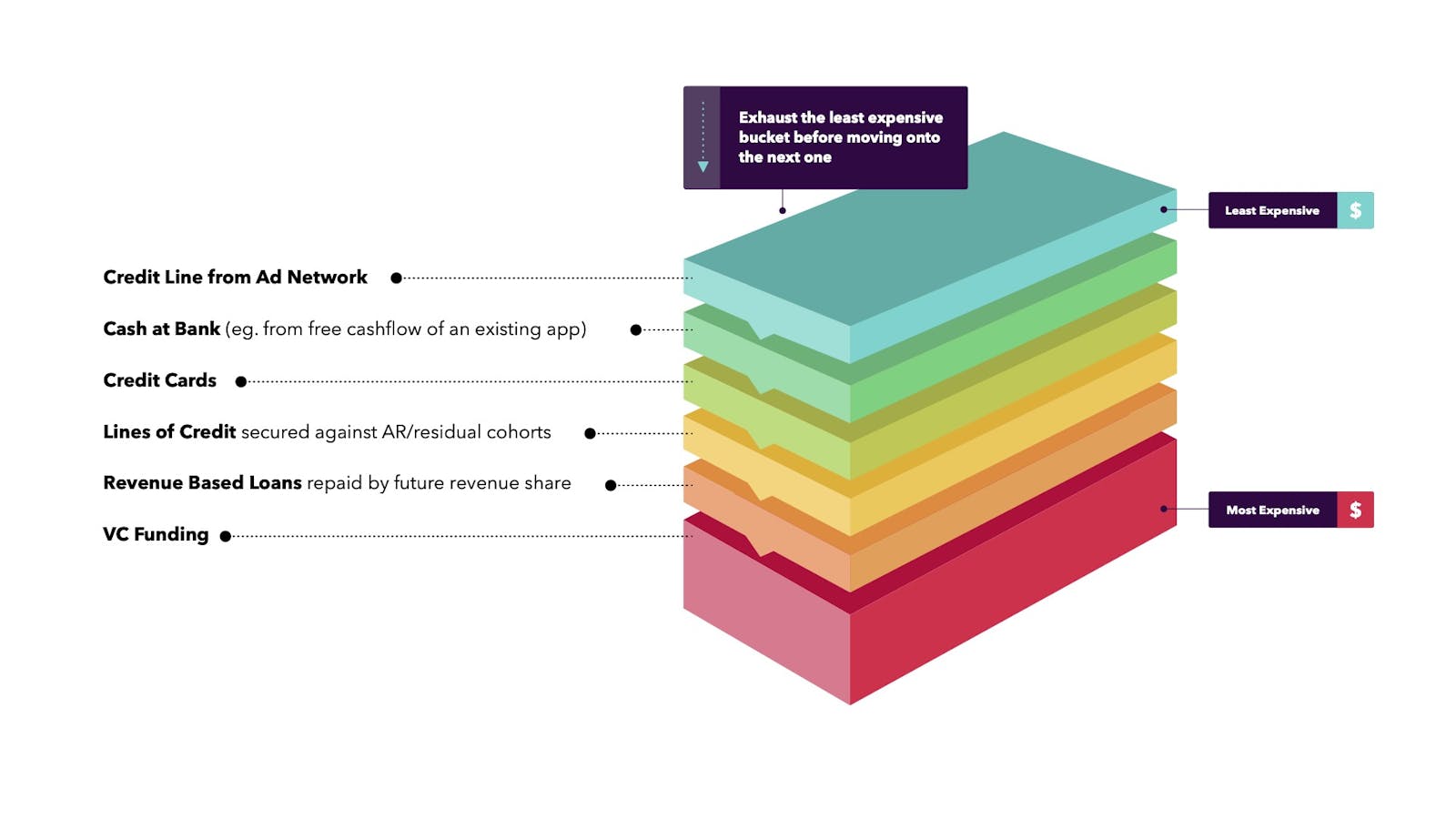
Once you’ve established you have built a user acquisition machine that works and is scalable - that is you can repeatedly invest capital into an ROI positive ad spend formula, then the next logical question becomes - "Where do I find the capital to fund my machine?"
Mobile gaming and app studios looking to scale often leave money on the table by looking at the numbers as an investor would, and finding the right form of capital to fuel the scaling process.
UA managers typically set budgets decided by whoever is running the finance function within their company. Traditionally a monthly marketing budget is allocated to the UA team where the goal is to acquire as many high-LTV users as possible for the funds available in that period.
But, rather than “How much money do I have to spend on UA?”, the smart question to ask is “If my UA machine is working, how do I find the cash to keep feeding the machine”?
To address this, we need to introduce the concept of Capital Efficiency - using the type of financing that will cost the company (and its founders) the least, in order to achieve the required scaling goal. To this, studios need to understand the concept of the Capital Stack - their range of funding options and costs/benefits associated with each, from lowest cost to highest cost, and work through these for as long as the UA investment opportunity exists.

Credit line from ad network
Cost: Free
Pros:
If an ad platform like Facebook or Google is prepared to give you a line of credit for purchasing ads, you should use this to the fullest extent possible - it is essentially an LTV risk transfer of 30-60 days from you to the ad network. If UA is working the credit line should be kept at max and interim payments made to pay it down in order to keep spending.
Cons:
It takes time to build up a credit history in order to build up a decent-sized credit line which may not be consistent with your timing objectives if you could continue to invest profitably after the line limit had been reached.
Also, for longer ROAS breakeven periods on the credit lines, there is a mismatch in when you break even on the ad spend (for example 180days) versus when the invoice needs to be paid (30 days from the end of the month). Invoicing schedules need to be carefully managed and paid on time to avoid credit lines being suspended or terminated.
Credit cards
Cost: Interest-Free period, thereafter ~18-24% per annum
Pros:
Credit cards can be a useful tool in the arsenal of UA but carry some limitations. Some developers enjoy significant air miles/travel benefits from using credit cards to fund UA, although this seems less common today. If you can meet your target UA spend, utilize the interest-free period and pay off the entire balance on the due date without stress, then it’s a very effective financing strategy.
Cons:
Most credit cards used to fund UA are the personal cards of founders. Limits granted to individuals (even with a good credit history) are not normally sufficiently large enough to properly scale a game or app. Repayment cycles on credit cards are not usually long enough to fund LTV cycles, so interest costs must be factored in beyond an interest-free period.
If the business is unable to reimburse the cardholder as soon as the interest-free period, interest becomes payable, and late payments can affect credit scores and are personally guaranteed if not using a corporate card.
Cash at bank (cashflow from an existing app)
Cost: Foregoing 0-1% per annum deposit interest
Pros:
If you have spare cash from existing operations (eg a game generating positive cash flow) this should be used next in the stack. Measure the ROI of the ad spend versus the lost cost of interest to figure out the ROI calculation.
Note: Do not confuse recently raised VC funding sitting in the bank earmarked for development costs with free cash flow from revenue-generating operations (see below)
Cons:
Most companies don’t have this luxury, hence look for sources of external capital to grow.
Revolving credit facility
Cost: 1-2% monthly
Pros:
Revolving credit facilities are a highly efficient way to finance growth. It allows you to borrow against both your AR (accounts receivable, notably In-app purchase sales from app stores and in-app ads served by ad networks). More sophisticated lenders can also lend against the value trapped in your existing user cohorts and allow you to borrow as soon as the next day if their verification process is fully automated.
This type of financing is low-cost, flexible, and non-dilutive for founders and scales with your business. Moreover, the costs typically decrease with additional volume.
Cons:
AR financing is not normally available from banks below a monthly revenue threshold of $1MM/month and requires VC backing, lending up to 80% of AR. Non-bank lenders have a lower minimum, normally around $25k in monthly revenues, do not require VC backing, and offer facilities of up to 4x monthly revenues.
Bank facilities are also not widely available outside the US and Canada and rely on a manual verification process at end of every month. Many financial institutions do not understand how to finance against AR where a traditional invoicing relationship does not exist. Fortunately, specialist lenders like Pollen VC offer a revolving credit line product tailored to digital marketplaces like app stores and ad networks.
All lenders are not created equal and our Definitive Guide to Selecting a UA Financing Partner is a resource to help unpack the different lending models and costs.
Revenue based loans
Pros:
Revenue-based loans can be a good fit for subscription-based apps. By offering loans with a fixed fee, but variable repayment terms based on business performance the developer knows the amount of interest that needs to be paid, which is structured as a revenue share over future revenues.
Cons:
Whilst the fee is fixed the repayment timing is not. For a business that is growing fast, the loans end up being paid off very quickly meaning the underlying interest rates charged are very high. It’s important to understand the underlying interest rates charged as fixed fee lending can obfuscate true financing costs.
Given that the loan's expected repayment path is from future revenue share, the loans can typically only be spent directly on user acquisition on specific channels.
You may find this calculator helpful in unpacking the effective interest rates charged by revenue-based lenders.
VC funding
Cost: Typically 20-30% equity per round
Pros:
Raising venture capital from a reputable VC gives you the money you need to deploy into your business to grow it. It comes packaged with advice and access to the VC’s network which can make valuable introductions and advice to help your business grow and generate a return for the investors. Activities like building new games, creating new IP, and scaling teams are a high-risk high rewards for the investor where equity financing is most appropriate.
Cons:
Using VC funding for predictable UA cycles is a very expensive way to grow. The funding raised has a high cost in terms of equity dilution, so you should reserve it to finance riskier activities in your company. Capital efficient founders typically use debt-based financing alongside their venture capital rounds to optimize their funding strategy and increasingly look to establish credit facilities at the same time as closing their VC rounds.
If you are raising funding and diluting your equity purely to fund predictable UA cycles you should consider all other alternatives first and only entertain raising VC funding if there is a super-compelling case where the equity dilution is worthwhile.
Summary
Capital efficient founders should think of the funding options listed in the above “capital stack” as a waterfall. Rationally you should want to exhaust the least expensive bucket before moving on to the next one and keep going until you can no longer profitably invest into additional user acquisition.
Another way of thinking about this is that your UA machine reached maximum capacity, where any incremental spend is likely to be loss-making, in other words where LTV<CAC
The unit economics of mobile user acquisition is really nothing more than demand economics 101. Click here to watch this short explainer video on the economics of mobile advertising.
This post is part 2 of a 3-part blog series on funding mobile growth:
Part 1 - How to Analyze User Acquisition Metrics Like a Hedge Fund Manager
Part 3 - When to Double Down or Stop Your User Acquisition Campaigns
Pollen VC provides flexible credit lines to drive mobile growth. Our financing model was created for mobile apps and game publishers. We help businesses unlock their unpaid revenues and eliminate payout delays of up to 60+ days by connecting to their app store and ad network platforms.
We offer credit lines that are secured by your app store revenues, so you can access your cash when you need it most . As your business grows your credit line grows with it. Check out how it works!